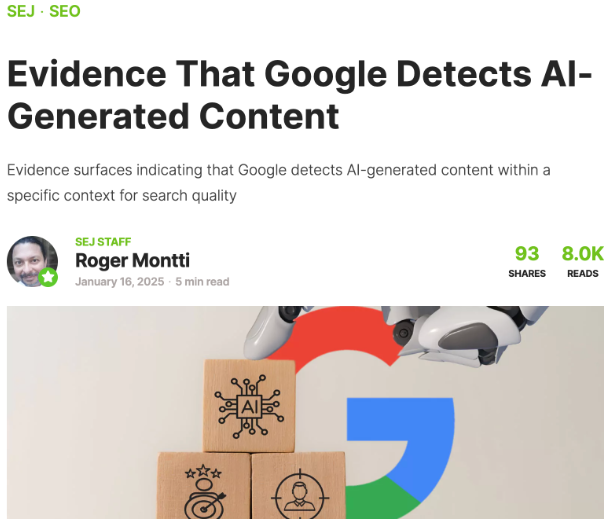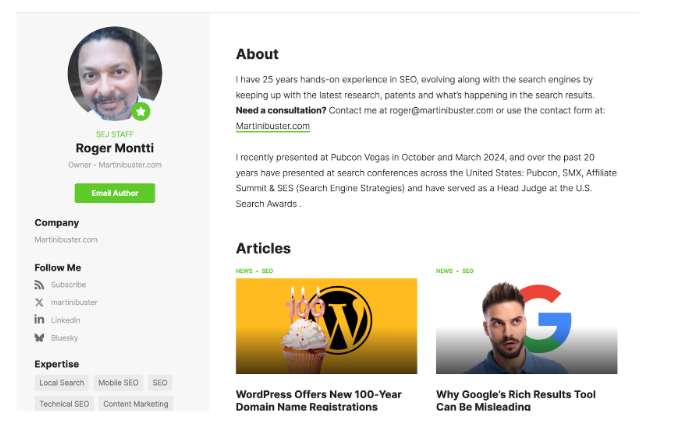To crack down on misinformation in content and enforce quality guidelines, Google came up with the concept of experience, expertise, authoritativeness, and trustworthiness, or E-E-A-T (previously E-A-T).
This emerged out of their Search Quality Rater Guidelines, which emphasize the importance of providing users with reliable, valuable, and accurate information and a great website experience.
If you give users what they want, and they trust you enough to keep coming back, Google is more likely to reward you in terms of rankings and traffic.
These concepts hold the most weight when it comes to Your Money or Your Life (YMYL) content – brands that provide information related to people’s health, finances, and well-being. This content must be reliable and fact-checked.
Quality Content, Care, And User Experience
When it comes to E-E-A-T, your top priority should be creating content that your target audience wants or needs – content that offers true value.
Your content should also be accessible, easy to navigate, and adhere to high standards of accuracy and reliability.
Creating these pages for your website should help it perform better in Google’s search results.
And, yes, this is much easier said than done. First, you must have a clear understanding of what Google means by “high-quality content.”
What Is High-Quality Content?
Whatever content you create must have a purpose. Your content must benefit your clients, customers, users, or readers.
Common Traits Of High-Quality Pages
According to the Search Quality Rater Guidelines, high-quality pages are those that have:
- High levels of experience, expertise, authoritativeness, and trustworthiness (E-E-A-T).
- A satisfying amount of high-quality main content, including a descriptive or helpful title.
- Satisfying website information and information about who is responsible for the website (for shopping pages or those that enable financial transactions, this includes satisfying customer service information).
- Placement on a website that has a strong reputation for being one of the best resources for information on the topic.
- A positive reputation for the creator of the main content, if different from that of the website.
The highest quality pages (including YMYL pages) will have an extremely high level of E-E-A-T, according to Google’s guidelines.
What Is Low-Quality Content?
Low-quality content is, as you’d expect, the exact opposite of high-quality content.
As Google puts it:
“Websites or pages without some sort of beneficial purpose, including pages that are created with no attempt to help users, or pages that potentially spread hate, cause harm, or misinform or deceive users, should receive the Lowest rating.”
If high-quality content helps your site rank higher, it logically follows that low-quality pages could hurt your Google rankings.
If your content is inaccurate, has no purpose, or includes elements that hurt the user experience, it’s unlikely that Google will feature your website prominently in the search engine results pages (SERPs).
Common Traits Of A Low-Quality Page
Here are the characteristics of a low-quality page, according to Google’s guidelines:
- The page has an inadequate level of experience, expertise, authoritativeness, and trustworthiness (E-E-A-T).
- The quality of the main content is low.
- There is an unsatisfying amount of main content for the purpose of the page.
- The title is exaggerated or shocking.
- Ads or secondary content distracts from the main content.
- There is an unsatisfying amount of website information or information about the creator of the content for the purpose of the page (no good reason for anonymity).
- The website or the content creator has a mildly negative reputation based on extensive reputation research.
In short, low E-E-A-T means bad content. Bad content means bad SEO, and bad SEO means you’re missing out on valuable traffic and conversions due to low rankings.
E-E-A-T In The Age Of Generative AI
Generative AI (Gen AI) has transformed content creation in a major way.
AI tools make it easier than ever to generate content at high volumes, and some use AI to mass-produce low-quality content that risks misinformation and generic insights.
To prioritize E-E-A-T, brands should create content backed by credible resources, research, and real-world expertise.
Gen AI can be useful in some respects, but you should never outsource your thoughts and insight to an AI tool.
Brands that publish original thought and prioritize human insight and expertise are in a better position to rank in search than those who rely on generative AI alone.
How To Improve Your Website’s E-E-A-T
So, how can you make sure your website content is high quality and also boost your on-page SEO efforts?
Here are some best practices to follow when creating new content.
1. Identify Your Authors With A Byline And Bio
Think about the last time you landed on a blog where some content was published by “Admin” or some random guy with no last name. Did you trust that site? Was the content amazing? No and no.
Google’s guidelines advise creating articles with “journalistic professionalism.”
Part of that professionalism means every piece of content you publish should have the writer’s name – their byline – attached to it.
Here’s how Search Engine Journal highlights the bylines of its articles:
 Screenshot of Roger Montti’s author byline, Search Engine Journal, February 2025
Screenshot of Roger Montti’s author byline, Search Engine Journal, February 2025Identify All Your Content Contributors
Ideally, you should highlight the biographical details of every person who creates content for you – whether that’s blog posts, articles, or question-and-answer pages.
Is the author of your content a recognized expert in your field? Then you definitely want to highlight that.
You can do so on a separate bio page that also contains the author’s past content, or you can even put it at the bottom of the article.
Search Engine Journal does both. At the bottom of any of its articles, you’ll see an author’s box.
Clicking on [Read full bio] leads to the full bio page with information that establishes who the author is and what they do:
 Screenshot of Roger Montti’s profile, Search Engine Journal, February 2025
Screenshot of Roger Montti’s profile, Search Engine Journal, February 2025In this example, Search Engine Journal highlights that the author, Roger Montti, brings “25 years hands-on experience in SEO,” “recently presented at Pubcon” (a reputable marketing conference), and “served as a Head Judge at the U.S. Search Awards.”
This bio clearly establishes Montti as a subject matter expert and authority when it comes to talking about (and writing about) SEO, which provides E-E-A-T to Search Engine Journal’s articles.
What To Include On A Bio Page
Here are some essential elements of a good bio page:
- Full name.
- Headshot.
- Title/position.
- A detailed bio.
- Contact information (e.g., email form, social media).
Doing all of this makes it easy for users (and Google) to know who created the content and assess their individual E-E-A-T.
2. Make Your Contact Info Easy To Find
When visitors arrive on your landing pages, is it easy to find your contact information?
Can they quickly determine how to get customer support?
Remember, E-E-A-T evaluates your website as a whole. The easiest solution is to make sure you link to your About Us and Contact Us pages in either your main or footer navigation.
If you don’t have those pages on your website, make them now!
3. Remove Or Improve Your Low-Quality Content
If you have content that is no longer useful – or is just so terrible that it’s not worth the time investment to update or improve it – then pruning that content is one quick way to improve your E-E-A-T.
You’ll need to decide whether to improve or remove your old or outdated content.
Removing content should always be your last resort, but if it needs to be done, do it without hesitation.
Ideally, you want to identify any content that looks like it has low E-E-A-T and figure out ways you can reverse that.
Here are some ways you could increase E-E-A-T on old content:
- Have a more authoritative person write the content.
- Add quotes from experts, data, sources, or citations.
- Make some simple edits to improve the readability, grammar, spelling, and structure.
- Add more information to make it more comprehensive.
- Write a new and better title.
- Add some visual appeal, such as photos, charts, and screenshots (and make sure to optimize those images).
- Add a video for people who prefer that format vs. text only (this has the added benefit of potentially keeping visitors on your site longer).
The process of elevating content definitely takes longer, but doing so will greatly improve your website’s E-E-A-T and performance. This process is especially crucial for any YMYL page.
4. Create A Positive Brand Reputation
A positive brand reputation is key to growing both your business and your E-E-A-T.
One way you can do this is through thought leadership by sharing insights that your target audience truly finds valuable.
High-quality thought leadership content is good for winning, keeping, and growing a business. It will also help you build authority in your niche and help Google trust you.
Thought leadership is incredibly powerful when done right, but to get it right, it needs expertise, experience and authority – all the things that represent E-E-A-T.
What’s Good For The User
Is E-E-A-T a ranking factor?
That is the wrong question to ask, in my opinion. Let’s forget about ranking factors for a moment and think about your audience instead.
If you’re doing everything outlined in Google’s E-E-A-T guidelines, then you’re creating informative, useful, high-quality content that your audience wants and helping them accomplish a task (e.g., acquiring knowledge, buying a product).
In other words, you’re providing a satisfying user experience.
Anything good for users is good for helping you be visible in Google – and driving the traffic and conversions you really want.
More Resources:
- Google’s E-E-A-T & The Myth Of The Perfect Ranking Signal
- Ask An SEO: Google E-E-A-T: Should We Search For Other Articles With High Backlink Profiles?
- The Complete Guide To On-Page SEO
Featured Image: insta_photos/Shutterstock





